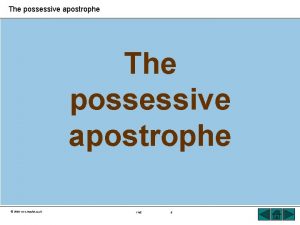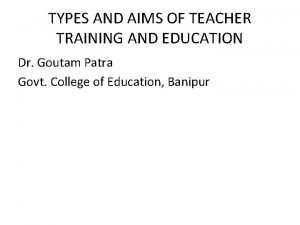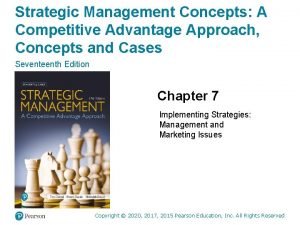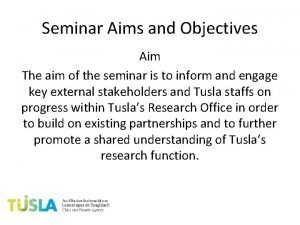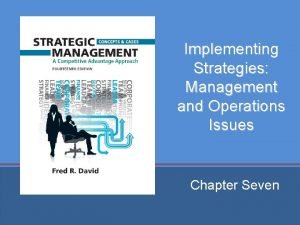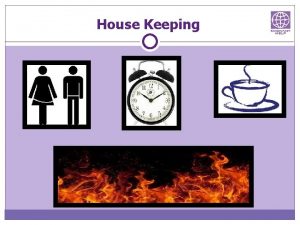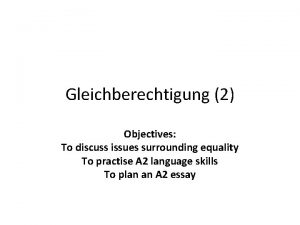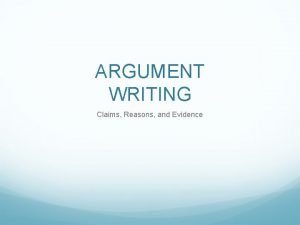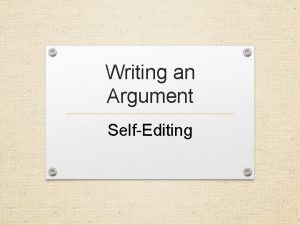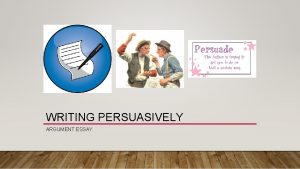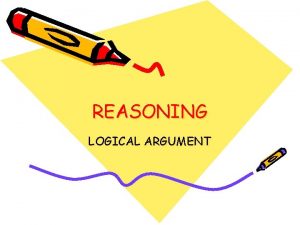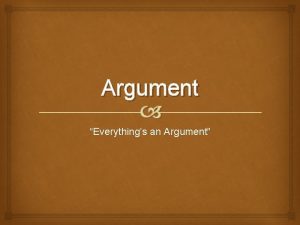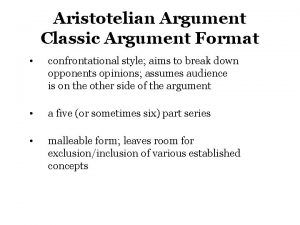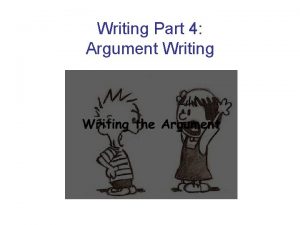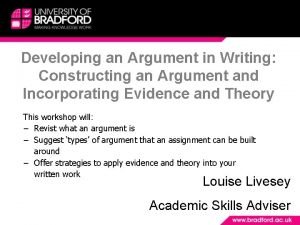Writing an argument Aims 2007 www teachit co



































- Slides: 35

Writing an argument Aims: © 2007 www. teachit. co. uk 4439 l To plan a piece of discursive writing l To structure a convincing argument. l To revise how to use transitional markers effectively 1

What are the ingredients of a good argument? l A number of views and opinions, both for and against a subject. l Well structured points progressing in a logical order. l A convincing and logical approach. l Language appropriate to the audience. l Use of ‘counter argument’ (‘You could state that …. However, this is clearly not the case because …. ’). l Tone appropriate for your audience. l Evidence - this will be slanted to support your pov. © 2007 www. teachit. co. uk 4439 2

CONTENT • Choose a Subject – Must interest you and you must have a definite view. Must be controversial, contentious. • Maintain a clear line of argument – Own views clearly presented, convincing argument backed up by explanation and evidence. • Brainstorm and Prioritise – Write down as many arguments as you can then select 4 or 5 that you feel are strongest. Use as basis for paragraph plan. • Acknowledge that there are other viewpoints – Deal with these and dismiss them in favour of own stance – be convincing. • Construct your argument – combination of opinion, supported by evidence, examples that illustrate point. You need to make your argument/opinion impossible to argue with © 2007 www. teachit. co. uk 4439 3

Choose a Topic… v You are interested in v You have a definite view about v Is current enough that you will find resources easily v Is not too ‘big’ for you to do justice to v Is contentious, controversial For Example: ‘Child Abuse’ in itself is not controversial (everybody would probably agree it is wrong!) Instead: ‘Child Abuse is easily preventable’ or ‘Should smacking a child be classed as child abuse? ’ © 2007 www. teachit. co. uk 4439 4

Planning your arguments l Firstly, construct a plan. This can take the form of a bullet pointed list or spider diagram – whatever suits you best. l Select your most convincing arguments to promote your p. o. v. l Remember to take the opposing viewpoint into consideration and break down their points to make your p. o. v. more convincing/persuasive. © 2007 www. teachit. co. uk 4439 5

K. W. L Grid Once you have selected your strongest, most convincing arguments you will have to do some research to find out facts, figures, examples, supporting detail and expert opinion that will add weight to your argument. • K - Write down points that you already KNOW e. g. Smoking has health implications • W - Write down things that you WANT to try and find out (questions) e. g. How many people in Scotland die of smoking related illnesses per year? • L - Write down what you have LEARNED (answers to questions) Remember to make a note of where you got the answer (the source) – who provided it (expert), what website/book/source, when you accessed it. © 2007 www. teachit. co. uk 4439 6

Researching your topic • • Newspapers/magazines Internet School and local library Documentaries News programmes TV debates Leaflets N. B. note down all your sources for a Bibliography/source list (with dates) © 2007 www. teachit. co. uk 4439 7

Persuasive Techniques Jargon – Technical language Puns – provides humour, play on words Persuaders – Clearly, naturally, self-evidently Bold Assertions – ‘It is a fact…’ © 2007 www. teachit. co. uk Repetition – Rule of 3 (Triad) Rhetorical Questions Emotive Language – strong connotations Manipulation of Tone Figurative Language – Create vivid picture, non -literal meaning 4439 8

Sentence Structure Must vary sentences to appeal to the reader – Grab attention and maintain interest. Sentence structure can reinforce meaning and by making it easier for reader to understand they are more inclined to believe your argument. Sentence Length – long (description, detailed explanation, relaxed) V short (action and impact) Creates dramatic effect Broken Sentences – Again for effect, minor/incomplete sentences. Single word for impact. Word Order – Inversion: alter normal order to emphasise particular word (start or end of sentence) © 2007 www. teachit. co. uk 4439 9

Punctuation • Careful use of punctuation can suggest different kinds of feeling, tone or atmosphere Dashes – stream of thoughts or impressions causing reader to share experiences. Colons – balance ideas against each other, introduce explanations, clarification, exemplification. Semi-colons and commas – separate list of qualities, feelings or facts. © 2007 www. teachit. co. uk 4439 10

So how should I structure my discursive piece? l Connective words can help you with this. l Look at the following list and select at least five of them to use in your own piece of argumentative writing. (transitional markers sheet) Firstly Secondly In addition © 2007 www. teachit. co. uk In the first place… To conclude Therefore In conclusion To begin with… Furthermore 4439 To sum up What is more… 11

Argumentative Structure © 2007 www. teachit. co. uk 4439 12

Come up with a question as your title – e. g. Should Capital Punishment be abolished? Introduction – Introduce your topic and state your personal feelings clearly – not using I Paragraph 2 – Introduce your first point in support of your viewpoint. Paragraph 3 – Make a second point in support and develop your argument. Paragraph 4 – Produce a final argument in support of your view. Paragraph 5 – State an opposite view and then say why you disagree with it. Paragraph 6 - State another opposite view and then say why you disagree with it. Paragraph 7 – final against view – make this point particularly strong – to lead to conclusion © 2007 www. teachit. co. uk 4439 13

Persuasive Structure © 2007 www. teachit. co. uk 4439 14

Come up with a title indicating direction of argument – e. g. ‘Making a Hash of the Drug Law’ or ‘The Dangers of Passive Smoking’ Introduction – Introduce your topic and make your stance clear – not using I Paragraph 2 – ARGUMENT 1 Present the first point in support of your position then develop the paragraph (Opinion + Evidence = Argument). Paragraph 3 – ARGUMENT 2 Repeat procedure for 2 nd point, preferably using a different approach to developing your argument. Paragraph 4 – ARGUMENT 3 – As for paragraphs 2 and 3 Paragraph 5 – Refutation/dismissal of opposite viewpoint – introduce alternative argument and dismiss it. State idea clearly then counter it with appropriate and clear response. Demonstrate you have thought about and around the subject – show confidence in your beliefs) Paragraph 6 – Restatement of attitude – finish by strongly reiterating argument and drawing on some main points. © 2007 www. teachit. co. uk 4439 15

Introductions A good introduction should grab the reader’s attention and engage them in the controversy under discussion You could do this by: State what the controversy is about – clearly showing what your stance is (No ‘I think’!!!) Illustrate the situation by creating a picture in the reader’s mind Use a rhetorical question Perhaps use a quotation from an expert © 2007 www. teachit. co. uk 4439 16

Main Body Clear explanation of argument/opinion Illustrate, exemplify opinion using evidence (statistics, expert opinion, examples, quotation) Topic Sentence – Varied and catchy Transitional Markers – helping to show direction and structure of argument Sub-conclusion – making stance clear, summing up attitude, points, linking to next point © 2007 www. teachit. co. uk 4439 17

Conclusion An effective conclusion should: Summarise and weigh up conflicting arguments Draw together main threads avoiding needless repetition End essay with powerful statement, leaving reader with no doubt about your views on issue Bibliography after conclusion: referencing all sources – name of website/publication, author, address, date accessed © 2007 www. teachit. co. uk 4439 18

Introductions All through history Capital Punishment has caused much controversy throughout the globe. Although it has been used for hundreds of years, the majority of countries today have already dismissed it as an accepted means of punishment. However, some countries such as Guatemala, Africa and areas of Asia still retain it, the most well known being the United States of America. Many people, even today, feel that taking the life of a criminal should be counted as justice. However, most countries now clearly feel that the death penalty is not an appropriate way to punish criminals. They argue that it is extremely expensive and does not benefit the justice system. So, should Capital Punishment be used, or should these cruel and unusual methods of punishment be abolished for good? Is this person for or against Capital Punishment? Explain why. © 2007 www. teachit. co. uk 4439 19

When we think of Capital Punishment, an immediate sense of controversy arises in the mind: there a myriad of divided views on the wrong doing of justice or the justified need to punish a criminal. Yet many people believe it is time to end this five hundred year old law as the value of life is too high. However, if a person is willing to commit the atrocity of killing another human being, they sacrifice their own right to life. So, is this punishment in fact just? • Is this person pro/anti Capital Punishment. Explain. • Strengths? • Areas for improvement? © 2007 www. teachit. co. uk 4439 20

Murder is the unlawful killing of another human being with an intentional or criminal intent. In today’s world, terrible crimes are being committed daily, and thus many people believe these criminals deserve one fate: death. While some argue that the ‘eye for an eye’ idea is a very competent way of punishing a crime, others believe that it causes more violence. So should this cruel way of ending a human life still be utilised or should it be abolished and left for the historians to study? • Is this person for or against Capital Punishment? • Strengths? • Areas to improve? © 2007 www. teachit. co. uk 4439 21

Exemplar paragraphs In support of their case The worst act a human being can commit is to take a fellow human being’s life. It takes away a life which could have continued to flourish and grow. Some people believe that after committing such a heinous crime, a person should receive the same fate as that of the victim. Logically, this makes no sense. Are there any positives to taking away the life of yet another human being? Would it bring the victim back from the dead? Would it extinguish or quench the victim’s family and friends’ grief? All a conviction or decision to kill a criminal would do is create an extensive and expensive trial. Remember, killing the criminal will not mean that she or he is declared innocent of their crimes. © 2007 www. teachit. co. uk 4439 22

One argument that is echoed through many modern-day countries is that all kinds of Capital Punishment are a complete waste of time and money. Even though methods of Capital Punishment are supposedly quick solutions to sentencing a criminal, many of the convicted spend weeks, months and even years waiting for their sentence to be carried out. This means that they can serving almost a full life imprisonment sentence, whilst they are waiting to be destroyed, which is, arguably a complete punishment in itself: waking up every single day not knowing whether you will live to see tomorrow. Additionally, while it can be argued that relatives or friends of the victimised see this extreme sentence as justice, most others feel that this is an expensive and unnecessary punishment and is just costing the government large sums of money that would be better spent on other things: such as, the police force, tax cuts, or solutions to the ever-growing credit crunch. © 2007 www. teachit. co. uk 4439 23

Equally important is the fact that this is the only form of punishment that cannot receive a reprieve: if a citizen is wrongly convicted and is sentenced to death, then there is no way for that citizen to be released. Atrocities like this only contribute to any doubts that exists in the public’s mind, and not one country in this world, needs or wants its people to have doubt in their own government. Those who are convicted of crimes they did not commit have died in vain. Were their deaths really necessary or could they have been prevented? Did the court make a simple mistake, or did they overlook valuable information? Nobody should have their life taken from them without good reason – and the justice system should make no exceptions. © 2007 www. teachit. co. uk 4439 24

Arguing against the opposition case Furthermore, many people who support Capital Punishment say that it is only fair to take the life of a criminal, if they have taken the life of another – as goes the saying ‘an eye for an eye. ’ Yet many people forget how the end of that proverb continues – ‘an eye for an eye…makes the whole world blind. ’ killing the offender may make the family of the victim feel safer, but it is absolutely pointless. What good has it done? Yes, they may be off the streets, unable to harm anyone else but that same feeling of security can be achieved through sentencing them to life imprisonment. People have to realise that killing that criminal is not going to bring back the friend or family member that they have lost. It is only going to create more hatred and violence in a world already too brutal and cruel. © 2007 www. teachit. co. uk 4439 25

Those in favour of Capital Punishment have often stated that exterminating criminals prevents any need for prisons – if those who commit crimes are killed, then they do not contribute to the serious overcrowding in many of our prisons. Yet many fail to remember that we cannot kill every person who commits a crime so there will always be a need for prisons. Furthermore, criminals still need to be housed until the time come for their execution, and this sometimes takes up to decades at a time. Also, once again, killing the criminals is extremely expensive ; therefore, it is much cheaper and morally acceptable to simple give a life sentence. © 2007 www. teachit. co. uk 4439 26

Conclusions Need to include: • Sum up main points of argument. • Strongly state how you feel about CP and reasons why. © 2007 www. teachit. co. uk 4439 27

Ultimately, Capital Punishment will always remain a disputed topic. Whether it is about morality or immorality, humanity or inhumanity, abolishment or prolongation, it will be a sustained argument for a long time to come. In one sense Capital Punishment is seen as immoral, expensive and an unnecessary waste of human life. Nevertheless we can easily see the need of Capital Punishment as a deterrent, a justified means of punishment and furthermore the solution to life sentenced murderers re-offending due to early release. Even for the latter reason alone, it is clear that Capital Punishment is necessary. Strengths? Areas for improvement? © 2007 www. teachit. co. uk 4439 28

In the modern world, we cannot and should not be adding to the death toll every year unnecessarily, simply because we feel it is justified. As we can clearly see, methods of Capital Punishment are utterly pointless: they are costing governments ridiculous amounts of money that could certainly be better spent on improving public services and lowering taxes, and therefore are doing no good whatsoever. Capital Punishment is not the way forward in today’s already violent world as the negatives considerably outweigh the positives. Ultimately, the entire argument over the death penalty can be summed up in one simple quotation from ‘Philosophy In The Bedroom’ by Marquis de Sade: “The law which attempts a man’s life is impractical, unjust, inadmissible. It has never repressed crime – for a second crime is every day committed at the foot of the scaffold. ” © 2007 www. teachit. co. uk 4439 29

How to make your essay more articulate “Distancing” Phrases: Use when arguing the case you don’t agree with. You will frequently find yourself obliged to mention points which you do not agree with or, at best, are not actually convinced by them. For that reason you should introduce them with a phrase which makes your position clear. The following list contains phrases which you will find useful. Do not be limited by it ; try to add as many of your own as you can. Many people believe that … There is a view that… It is thought that … It has been claimed that … Those who support/oppose ……will maintain that… Supporter/opponents of …… will argue One popular theory suggests … It is very important to vary your choice of distancing phrases to give © 2007 www. teachit. co. uk 4439 30

Phrases and words which “turn” the argument. When you have set out a point which you do not support it is important to counter it efficiently. To this you will find it useful to introduce your counter argument with one of these words or phrases. However… contrary …. On the other hand… Nevertheless …. The truth of the matter is In fact…. . On the Add others as you think of them. Once again variety is essential! © 2007 www. teachit. co. uk 4439 31

Transitional Markers Introduce Sequence Compare Continue Change Contrast Give Reason Or Result Give Summarising Examples Furthermore However Therefore For example © 2007 www. teachit. co. uk 4439 To conclude 32

Advice • Formal writing – no contraction etc. do not instead of don’t – vocabulary you would see in a good quality newspaper. • Absolutely no I • No second person – you = informal. We is fine. • Make your points for the side you support as convincing and as powerful as possible. • Make your arguments against the side you oppose as persuasive as possible. Break down their case as strongly as you can. © 2007 www. teachit. co. uk 4439 33

Bibliography Then just bullet point the websites/books etc. • Mc. Neil, Robert, The Scotsman, 11 th April 2008 • Bell, Emily ‘The Leveson inquiry is irrelevant to 21 st-century journalism’, The Guardian Online, <http: //www. guardian. co. uk/commentisfree/2012/nov/28/leveson-irrelevant 21 st-century-journalism> , accessed on 29 th November 2012 © 2007 www. teachit. co. uk 4439 34

So … over to you l Now that you have thought of a number of arguments for and against, and have an idea of how to create a counter argument, you are ready to write your response. l Remember to use transitional markers. Good Luck! © 2007 www. teachit. co. uk 4439 35
 Teachit.co.uk
Teachit.co.uk Ontological argument
Ontological argument Advantages and disadvantages essay structure
Advantages and disadvantages essay structure Summary writing objectives
Summary writing objectives Writing an argument portfolio
Writing an argument portfolio Examples of specific aims
Examples of specific aims Three main aims of the sia
Three main aims of the sia Aims of teaching
Aims of teaching Objectives of unemployment
Objectives of unemployment Types of aims
Types of aims Treasure role
Treasure role Aims and methods of scouting
Aims and methods of scouting The stamus company's hierarchy of aims
The stamus company's hierarchy of aims Aims of pharmacovigilance
Aims of pharmacovigilance Seminar objective
Seminar objective Defects of secondary education
Defects of secondary education What are the health services provided by school
What are the health services provided by school Graphic organizer with the aims of la liga filipina
Graphic organizer with the aims of la liga filipina What is health psychology
What is health psychology Aims of pharmacovigilance
Aims of pharmacovigilance Definition of industrial estate
Definition of industrial estate Below the line promotion
Below the line promotion Objective of discipline
Objective of discipline Listening aims
Listening aims Aims nursing
Aims nursing Define pharmacovigilance
Define pharmacovigilance Introduction to chemistry
Introduction to chemistry Interior design objective
Interior design objective Write a short note on industrial estate
Write a short note on industrial estate Kothari commission report
Kothari commission report The stamus company's hierarchy of aims
The stamus company's hierarchy of aims Policies largely dictate how structure will be established.
Policies largely dictate how structure will be established. Aims and objectives of human trafficking
Aims and objectives of human trafficking Health teaching definition
Health teaching definition Aims and ambitions vokabeln
Aims and ambitions vokabeln Social health
Social health
